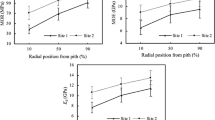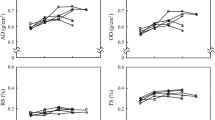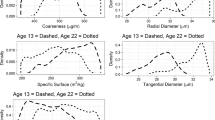Summary
Loblolly pine microtome sections 100μm thick were tested wet in tension. This thickness was approximately double the outside diameter of tracheids. Results indicate a curvilinear relationship between tensile strength and specific gravity of microspecimens combining both earlywood and latewood zones. Contrary to expectations the rate of change in slope of curve, expressed as tangent angles, decreased as specific gravity increased. Both tensile strength and stiffness values of these microspecimens are low in relation to their specific gravity. This reduction in strength and stiffness is probably related to the low ratio of microspecimen thickness to tracheid diameter, but needs further investigation. If the proper ratio between microspecimen thickness and tracheid diameter is determined, the transitional variation in tensile strength and stiffness within growth ring may be accurately established. The transitional variation in specific gravity can be successfully established from microtome sections, however the method is time consuming and not completely free of errors.
This study is a part of a larger study that concerns the determination of several mechanical properties of the earlywood and latewood zones of southern yellow pine in relation to their anatomical characteristics.
The part presented in this paper concerns the following objectives:
-
1.
To determine whether microtome sectioned specimens can be successfully used to establish the transitional variation in physical properties within loblolly pine (Pinus taeda L.) growth rings.
-
2.
To investigate the relationships between tensile properties and specific gravity obtained from testing microtome specimens within loblolly pine rings.
Zusammenfassung
100 μm dicke Loblolly Pine Mikroschnitte wurden in nassem Zustand einer Zugfestigkeitsprüfung unterworfen. Die gewählte Dicke entsprach ungefähr dem Zweifachen des Tracheiden-Außendurchmessers. Aus den Ergebnissen ergibt sich ein kurvilinearer Zusammenhang zwischen der Zugfestigkeit und der Dichte der Mikroproben, wobei Früh- und Spätholzzonen gemeinsam erfaßt sind. Entgegen den Erwartungen fiel der Neigungswinkel der Kurven, ausgedrückt als Tangentenwinkel, mit steigender Dichte ab. Zugfestigkeits- und Steifigkeitswerte der Mikroproben sind im Verhältnis zu ihrer Dichte klein. Diese Festigkeits- und Steifigkeitsminderung hängt wahrscheinlich mit dem niedrigen Verhältnis von Dicke zu Tracheidendurchmesser der Mikroproben zusammen, jedoch muß dieser Umstand noch weiter untersucht werden. Wenn es gelingt, das Verhältnis von Dicke zu Tracheidendurchmesser der Mikroproben genau zu bestimmen, wird es auch möglich sein, die Änderungen der Zugfestigkeit und der Steifigkeit innerhalb eines Jahrringes genau festzulegen. Die Dichteänderung kann ebenfalls gut mit Hilfe von Mikroschnitten ermittelt werden, jedoch ist das Verfahren sehr zeitaufwendig und noch nicht frei von Fehlerquellen.
Die vorliegende Arbeit ist Teil einer größeren Untersuchung, welche die Bestimmung mehrerer mechanischer Eigenschaften des Früh- und Spätholzes von Southern Yellow Pine im Verhältnis zu deren anatomischen Eigenschaften zum Ziel hat. Der hier vorgelegte Teil behandelt folgende Punkte, erstens, inwieweit sind Mikroschnitte für die Bestimmung der Änderung der physikalischen Eigenschaften innerhalb eines Jahrringes von Loblolly Pine (Pinus taeda L.) geeignet, zweitens, Untersuchung der Beziehungen zwischen Zugfestigkeitseigenschaften und Dichte innerhalb eines Loblolly Pine Jahrringes ermittelt aus der Prüfung von Mikroschnitten.
Similar content being viewed by others
References
Dedaise, G. G., A. W. Porter, and B. G. Pentoney: Morphology and Mechanics of Wood Fracture. ASTM, Materials Research and Standards Vol. 6 (1966) p. 493/499.
Echols, R. M.: Linear Relation of Fibrillar Angle to Tracheid Length and Genetic Control of Tracheid Length in Slash Pine. Tropical Woods, No. 102, p. 11/12. Yale School of Forestry, New Haven, Conn., 1955.
Fitzgerald, J. D.: Shear Properties of Earlywood and Latewood of Loblolly Pine. M. Sc. Thesis, Dept. of Forestry, Auburn Univ., Auburn, Ala. 1968.
Forsaith, C. C.: The Strength Properties of Small Beams (Match Stick Size) of Southern Yellow Pine. Bull. No. 42, N. Y. State College of Forestry, Syracuse, N. Y. 1933.
Garland, H.: A Microscopic Study of Coniferous Wood in Relation to its Strength Properties. Annals Missouri Botanical Garden Vol. 26 (1939) p. 1/93
Hill, J. L.: A Simple Method for Selecting Balsa of High Tensile Strength. Forest Prod. Res. Soc. Proc. Vol. 3 (1949) p. 413/424.
Hill, J. L.: The Influence of Rate of Cell Formation and Certain Anatomical Characteristics on the Strength of Connecticut Grown Red Oak. Doct. Diss., School of Forestry, Yale Univ., 1954.
Ifju, G., and R. W. Kennedy: Some Variables Affecting Microtensile Strength of Douglas-fir. For. Prod. J. Vol. 12 (5) (1962) p. 213/217.
—: Relationship Between Certain Intra-Increment Physical Measurements in Douglas Fir. Pulp and Paper Mag. Canada. Vol. 66 (1965) p. T-475/483.
Kellogg, R. M., and G. Ifju: Influence of Specific Gravity and Certain Other Factors on the Tensile Properties of Wood. For. Prod. J. Vol. 12 (1962) p. 463/470.
Kennedy, R. W., and G. Ifju: Applications of Microtensile Tensile to Thin Wood Sections. Tappi I. Vol. 45 (1962) p. 725/733.
Kloot, N. H.: A Micro-testing Technique for Wood. Austr. J. Appl. Sc. Vol. 3 (1952) p. 125/143.
Kraemer, J. H.: Growth-strength Relations of Red Pine. J. of Forestry Vol. 48 (1950) p. 842/849.
Van Vliet, A. G.: Strength of second-growth Douglas-fir. For. Prod. J. Vol. 9 (1959) p. 143/148.
Wardrop, A. B.: Cell Wall Organization and the Variation of Breaking Load in Tension of the Xylem in Conifer Stems. Austr. J. Appl. Sc. Vol. 4 (1951) p. 391/414.
Wellwood, R. W.: Tensile Testing of Small Wood Samples. Pulp and Paper Mag. Canada Vol. 63 (1962) p. T61/67.
Author information
Authors and Affiliations
Additional information
This research was carried out at the Department of Forestry, Auburn University and was supported partially by federal grant funds under the Hatch Act and Alabama State appropriated funds. Acknowledgment is made to Dr. Amelie C. Blyth in appreciation for her assistance in the various phases of preparation and measurement of the microtome sections.
Rights and permissions
About this article
Cite this article
Biblis, E.J. Transitional variation and relationships among properties within loblolly pine growth rings. Wood Science and Technology 3, 14–24 (1969). https://doi.org/10.1007/BF00349981
Received:
Issue Date:
DOI: https://doi.org/10.1007/BF00349981




